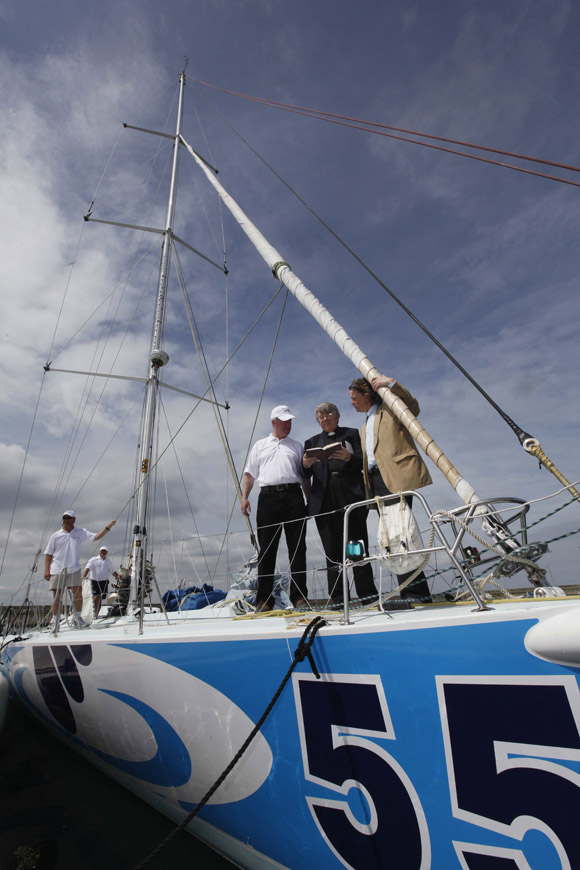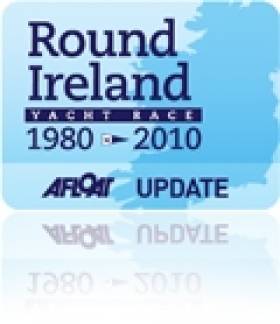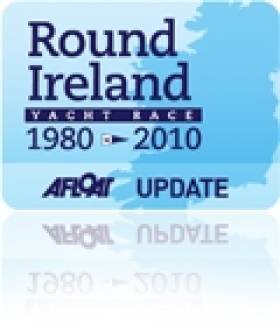Displaying items by tag: Spirit of Rosslare Europort
'Rosslare' Blessed in Dun Laoghaire and Bound for Wicklow
The “Spirit of Rosslare Europort”, was the centrepiece of a traditional Irish ceremony in Dun Laoghaire Harbour this afternoon. In an interdenominational event, the yacht took part in the “Blessing of the Boats” ceremony prior to setting out for the Round Ireland Yacht race. The ceremony was conducted by Fr John McDonagh from Dalkey and the Rev. Gary Dowd from Glenageary.
The Blessing of the Boat’s ceremony is a widespread tradition all around the coast of Ireland and on inland waters. Annual ceremonies take place in Bulloch Harbour in Dalkey, and in other centres around Dublin, including Poolbeg and Balbriggan, and are often a part of local festivals. Boats of all sorts and sizes participate, ranging from sea going trawlers to sailing yachts, Galway Hookers, lifeboats and small craft.

Pictured at the blessing of The Spirit of Rosslare Europort yacht were Alan McGettigan, Fr John McDonagh and Rev.Gary Dowd, at Dun Laoghaire Marina, with crewmen Peter O'Mally and Paul O'Riain in the background. The 60 foot yacht is competing in this weekend's Round Ireland Race.
Speaking at the blessing, Fr McDonagh said “For centuries the Blessing of the Boats ceremony has been an expression of faith by sea going communities in Ireland and represents an age old tradition”.
The Rev Dowd said: “It is entirely appropriate that in our modern age this ancient tradition should be observed with the blessing of a high technology yacht that has been a leading competitor in round the world races and is now going to circumnavigate Ireland”.
The group sailing the yacht is led by Dalkey man Alan McGettigan whose initiative it was to bring the “Spirit of Rosslare Harbour” to Ireland and to conduct the ancient Irish traditional blessing. An experienced sailor, Mr McGettigan has sailed in areas as far afield as the Baltic Sea, the Caribbean, the South China Sea and the Mediterranean. He is a member of the Royal Irish Yacht Club.
The 60 foot long Spirit of Rosslare Europort has sailed around the world four times, competed in numerous transatlantic races and is expected to be the fastest boat in next week’s 704 mile race around the island of Ireland. The yacht has been sponsored by Rosslare Europort and will be skippered by Steve White, the renowned solo round world sailor who’s company White Ocean Racing owns the vessel.
Sailing enthusiasts will be able to track the Spirit of Rosslare’s progress in the Round Ireland Race on Twitter and Facebook. The Facebook page features photos and video footage thanks to onboard camera’s which will give people an insightful view of how sailors overcome the various challenges during the course of the race.
Round Ireland Yacht to be Blessed
An entry in the Round Ireland Yacht Race will be blessed in an interdenominational ceremony in Dun Laoghaire Harbour on Friday, prior to departing for the race.
The blessing of boats going to sea is an Irish tradition practiced all around the coast of Ireland.
The yacht is the 60 foot "Spirit of Rosslare Europort" that has competed in Round the World Races on four occasions, the fastest boat entered in the race.
The ceremony at Dun Laoghaire marina will be conducted by Fr John McDonagh from Dalkey and Rev. Gary Dowd from Glenageary.
More on the Round Ireland Yacht Race:
Round Ireland Yacht Race 2010 Review
Round Ireland Yacht Race, Ireland's top offshore fixture
A Round up of 80 stories on the 2010 Round Ireland Yacht Race





























































